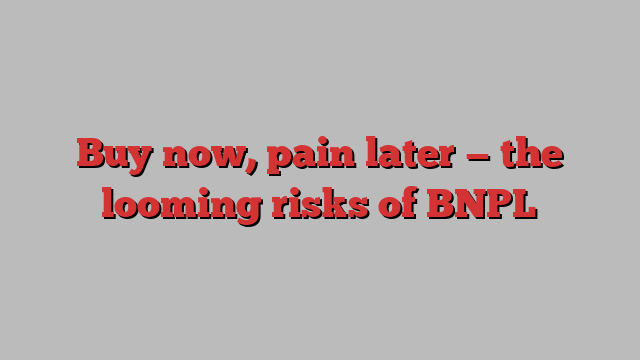
Unlock the Editor’s Digest for free
Roula Khalaf, Editor of the FT, selects her favourite stories in this weekly newsletter.
Buy now, pay later could be the maxim of governments across the world. With national debt to GDP ratios on the rise from the US to the UK to Japan, the principle of having things before you can afford to pay for them has become a 21st century norm.
Living beyond your means may be sustainable, for a while at least, if you are a country with a trusted government or you have the backing of the world’s reserve currency. But for many customers of the fast-growing consumer finance phenomenon, BNPL looks rather more of a risk.
According to Britain’s Citizens Advice consumer charity, the number of people who have come to them for help in relation to BNPL so far this year is more than double the tally for the whole of 2022. That suggests problem borrowing in this area (which it has nicknamed “buy now, pain later”) is growing at least twice as fast as the industry itself. (Market leader Klarna generated 47 per cent more operating income in the first half of 2024 than two years earlier.)
The great benefit of BNPL is also its greatest potential problem. As with so much else in our increasingly digital world, BNPL has eliminated friction: compared with traditional consumer finance — the elaborate form-filling, the long-winded credit checks, the frustrating waits for approval — BNPL is refreshingly quick and easy. You can buy that £3,000 sofa with three £1,000 instalments over three months. It’s quick, easy and if you pay on time, there is typically no interest (with the lender making most money from merchant commissions). In this sense it is comparable with a credit card with a triple-length free credit period (albeit without fringe benefits such as purchase insurance or spending points).
But the big downside is the potential for debt to spiral because of its very frictionlessness. Unlike a credit card which will have a preset spending limit determined by your credit score, it is possible to rack up a theoretically limitless quantity of BNPL spending; it is not uncommon for the most spendthrift individuals to have several dozen overlapping loans from a range of providers.
Unsurprisingly this makes it far more likely that BNPL borrowers will default — either on their BNPL loans themselves, or on other credit. According to a study by the Bank for International Settlements, US BNPL users had an overall credit delinquency rate of close to 18 per cent, compared with about 7 per cent for non-BNPL users.
Buyer beware, cry the unadulterated free marketeers. But a combination of sharp practice by some BNPL providers (via punitive, poorly disclosed late fees, for example), and the rapidly expanding scale of the industry, has persuaded policymakers, belatedly, to draw this largely unregulated area of consumer finance into the ambit of conduct regulators. The UK government last week launched legislative consultation to bring BNPL under the supervision of the Financial Conduct Authority. In May, the US made a similar move.
Another sign that BNPL is maturing is evident in its funding methods. Last week it emerged that Klarna had struck a deal with hedge fund Elliott to shift £30bn of future loans off its balance sheet, potentially turbocharging its growth, particularly in its priority market of the US. The deal — a kind of securitisation that leaves the consumer relationship with Klarna but passes the risk to Elliott in exchange for an undisclosed discount on the value of the loan — frees up funding. But it is principally driven by Klarna’s desire to alleviate capital strains, given that it is a deposit-taking bank with an obligation to meet toughening Basel III capital requirements. The Elliott deal echoes the fashion among European banks for so-called significant risk transfer, or SRT, deals over the past couple of years.
A few other BNPL loan packages have been securitised in the past. Pay Pal notably offloaded a €40bn flow of credit to KKR last year (though that was more akin to a standard consumer finance securitisation, given PayPal’s long record and its reputation for making lower-risk BNPL loans that do not rely on referrals from volume-hungry merchants).
If such refinancing deals become standard in BNPL, it won’t only be consumer regulators that should be keeping an eye on this rocketing part of the credit market. As with the trend for private capital groups to partner with traditional banks (which this column probed a fortnight ago), prudential regulators should be monitoring that the risks of BNPL do not become as systemically destabilising as individual loans can be for out-of-control borrowers.